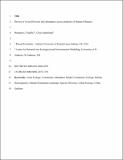Files in this item
Drivers of avian diversity and abundance across gradients of human influence
Item metadata
| dc.contributor.author | Padilla, Benjamin J. | |
| dc.contributor.author | Sutherland, Chris | |
| dc.date.accessioned | 2023-02-28T00:43:38Z | |
| dc.date.available | 2023-02-28T00:43:38Z | |
| dc.date.issued | 2022-04-01 | |
| dc.identifier | 278226967 | |
| dc.identifier | 4307d8f5-5f8a-4bdc-bfa9-91aac2d5418f | |
| dc.identifier | 85125381588 | |
| dc.identifier | 000762155400001 | |
| dc.identifier.citation | Padilla , B J & Sutherland , C 2022 , ' Drivers of avian diversity and abundance across gradients of human influence ' , Landscape Ecology , vol. 37 , no. 4 , pp. 968-981 . https://doi.org/10.1007/s10980-022-01422-y | en |
| dc.identifier.issn | 0921-2973 | |
| dc.identifier.other | RIS: urn:C12724793AD9DA6426BC1BB2EBDB14B5 | |
| dc.identifier.other | ORCID: /0000-0003-2073-1751/work/109766880 | |
| dc.identifier.uri | https://hdl.handle.net/10023/27071 | |
| dc.description.abstract | Context : Identifying factors driving patterns of species communities in heterogenous human-dominated landscapes remains elusive despite extensive research. Biodiversity is thought to decrease with habitat modification, as sensitive species are lost. Conversely, diversity has also been shown increase at moderate levels of landscape modification where greater habitat heterogeneity supports a diverse suite of species. Objectives : We explore patterns of avian diversity and abundance in heterogenous landscapes using a novel integration of multiple dimensional gradients of human-mediated modification. Methods : We attempt to identify aspects of landscape heterogeneity driving patterns of avian diversity and abundance in agro-urban–rural systems. Specifically, we utilize an intuitive multi-dimensional gradient distinguishing between two axes of human-influence, variation in the built environment (hard–soft) and in agricultural development (green–brown). We use these as covariates in community N-mixture models to describe variation in species abundance and diversity. Results : Avian richness was greatest in more heterogeneous regions of the landscape. Responses of individual species were variable, with sensitive species declining, while generalist species increased, leading to higher overall diversity in human-dominated regions. Conclusions : Species abundance and diversity is maximized in more heterogeneous parts of landscape mosaics. By characterizing distinct axes of human influence that capture spectrum of land use, we can identify differential effects confounded in traditional landscape metrics. Critically, we demonstrate that multi-dimensional landscape gradients provide a more nuanced understanding of how patterns of biodiversity emerge. Acknowledging that biodiversity is not always negatively impacted by habitat modification offers encouraging insight to guide conservation and management in human-dominated landscapes. | |
| dc.format.extent | 13 | |
| dc.format.extent | 1027725 | |
| dc.language.iso | eng | |
| dc.relation.ispartof | Landscape Ecology | en |
| dc.subject | Avian ecology | en |
| dc.subject | Community ecology | en |
| dc.subject | Community-abundance model | en |
| dc.subject | Habitat heterogeneity | en |
| dc.subject | Human-dominated landscape | en |
| dc.subject | Species diversity | en |
| dc.subject | Urban ecology | en |
| dc.subject | Urban gradient | en |
| dc.subject | GF Human ecology. Anthropogeography | en |
| dc.subject | QH301 Biology | en |
| dc.subject | DAS | en |
| dc.subject | SDG 15 - Life on Land | en |
| dc.subject | AC | en |
| dc.subject | MCC | en |
| dc.subject.lcc | GF | en |
| dc.subject.lcc | QH301 | en |
| dc.title | Drivers of avian diversity and abundance across gradients of human influence | en |
| dc.type | Journal article | en |
| dc.contributor.institution | University of St Andrews. Statistics | en |
| dc.contributor.institution | University of St Andrews. Centre for Research into Ecological & Environmental Modelling | en |
| dc.identifier.doi | 10.1007/s10980-022-01422-y | |
| dc.description.status | Peer reviewed | en |
| dc.date.embargoedUntil | 2023-02-28 |
This item appears in the following Collection(s)
Items in the St Andrews Research Repository are protected by copyright, with all rights reserved, unless otherwise indicated.

